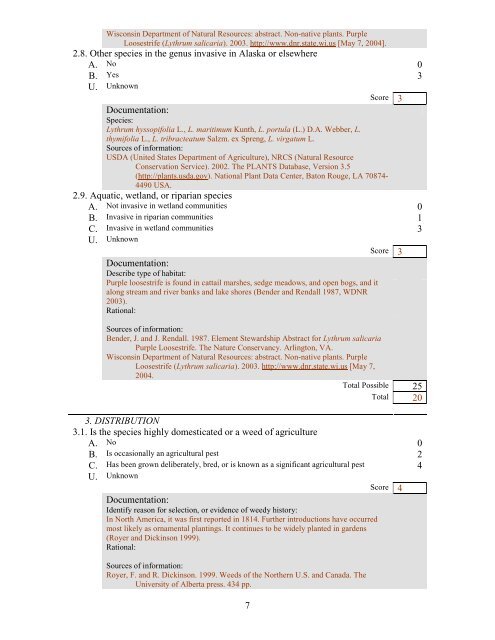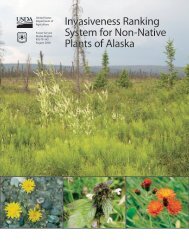AQIS Weed Risk Assessment - Alaska Natural Heritage Program
AQIS Weed Risk Assessment - Alaska Natural Heritage Program
AQIS Weed Risk Assessment - Alaska Natural Heritage Program
You also want an ePaper? Increase the reach of your titles
YUMPU automatically turns print PDFs into web optimized ePapers that Google loves.
Wisconsin Department of <strong>Natural</strong> Resources: abstract. Non-native plants. PurpleLoosestrife (Lythrum salicaria). 2003. http://www.dnr.state.wi.us [May 7, 2004].2.8. Other species in the genus invasive in <strong>Alaska</strong> or elsewhereA. No 0B. Yes 3U. UnknownScore 3Documentation:Species:Lythrum hyssopifolia L., L. maritimum Kunth, L. portula (L.) D.A. Webber, L.thymifolia L., L. tribracteatum Salzm. ex Spreng, L. virgatum L.Sources of information:USDA (United States Department of Agriculture), NRCS (<strong>Natural</strong> ResourceConservation Service). 2002. The PLANTS Database, Version 3.5(http://plants.usda.gov). National Plant Data Center, Baton Rouge, LA 70874-4490 USA.2.9. Aquatic, wetland, or riparian speciesA. Not invasive in wetland communities 0B. Invasive in riparian communities 1C. Invasive in wetland communities 3U. UnknownScore 3Documentation:Describe type of habitat:Purple loosestrife is found in cattail marshes, sedge meadows, and open bogs, and italong stream and river banks and lake shores (Bender and Rendall 1987, WDNR2003).Rational:Sources of information:Bender, J. and J. Rendall. 1987. Element Stewardship Abstract for Lythrum salicariaPurple Loosestrife. The Nature Conservancy. Arlington, VA.Wisconsin Department of <strong>Natural</strong> Resources: abstract. Non-native plants. PurpleLoosestrife (Lythrum salicaria). 2003. http://www.dnr.state.wi.us [May 7,2004.Total Possible 25Total 203. DISTRIBUTION3.1. Is the species highly domesticated or a weed of agricultureA. No 0B. Is occasionally an agricultural pest 2C. Has been grown deliberately, bred, or is known as a significant agricultural pest 4U. UnknownScore 4Documentation:Identify reason for selection, or evidence of weedy history:In North America, it was first reported in 1814. Further introductions have occurredmost likely as ornamental plantings. It continues to be widely planted in gardens(Royer and Dickinson 1999).Rational:Sources of information:Royer, F. and R. Dickinson. 1999. <strong>Weed</strong>s of the Northern U.S. and Canada. TheUniversity of Alberta press. 434 pp.7
















